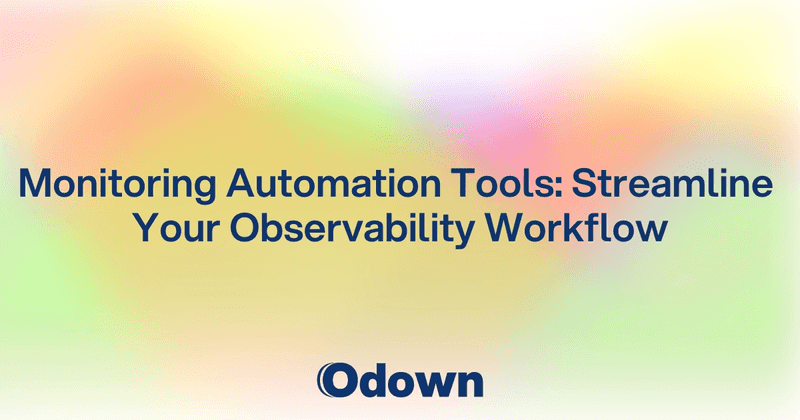Monitoring Automation Tools: Streamline Your Observability Workflow
Let me paint you a picture. It's 2 AM, and your phone buzzes with yet another alert. You check it groggily - it's the same false positive about CPU usage that's been going off every night this week. You silence it and go back to sleep, secretly hoping nothing important breaks while you're ignoring alerts.
Sound familiar? This is the reality for most operations teams still doing monitoring the old-fashioned way. They're drowning in alerts, spending their days tweaking thresholds and chasing false positives instead of actually improving their systems.
There's a better way. Smart teams are using monitoring automation tools to handle the tedious stuff automatically. They sleep better at night and spend their days on work that actually moves the needle.
The Problem with Old-School Monitoring
Remember when monitoring meant checking a few servers and maybe watching some basic metrics? Those days are long gone. Now you've got microservices, containers, serverless functions, multiple cloud providers, and a dozen different databases all talking to each other.
The math doesn't work anymore. One person can't manually monitor 50 different services, each with their own quirks and failure patterns. Yet that's exactly what most teams try to do.
I've seen operations teams burn out because they're constantly firefighting. They set up hundreds of alerts manually, spend hours tuning thresholds, and still miss critical issues because they're overwhelmed by noise. Meanwhile, their developers keep shipping new features that need monitoring, and the cycle gets worse.
The worst part? Most monitoring alerts are useless. Studies show that up to 90% of monitoring alerts are false positives or so obvious that they don't require immediate action. That means teams are interrupting their sleep and work for nothing 9 times out of 10.
Manual monitoring also creates knowledge silos. The person who set up monitoring for the payment system is the only one who really understands how it works. When they go on vacation or change jobs, their knowledge leaves with them.
What Makes Monitoring Automation Actually Useful
I've seen plenty of "automation" tools that just make things more complicated. The good ones share a few key traits that separate useful automation from vendor marketing.
They Learn Your Environment
The best monitoring automation tools don't just blindly apply generic rules. They spend time learning how your systems normally behave, then adjust their monitoring accordingly.
For example, if your API response times spike every Monday morning when people check their weekend emails, good automation tools learn that pattern and stop alerting about it. Bad tools will wake you up every Monday at 8 AM forever.
This learning happens across different dimensions too. Traffic patterns, error rates, resource usage - everything gets baselined so the system knows what normal looks like for your specific environment.
They Handle the Boring Stuff
Great automation tools take care of the repetitive tasks that eat up your time. When you deploy a new service, they automatically set up basic monitoring without you having to configure everything from scratch.
They also handle alert routing intelligently. Database alerts go to database people, application errors go to developers, and infrastructure issues go to operations teams. No more playing "hot potato" with alerts that landed in the wrong inbox.
The mundane maintenance tasks get automated too. Clearing old logs, rotating certificates, restarting stuck processes - all the stuff that doesn't require human creativity but still needs to happen.
They Get Out of Your Way
The worst automation tools force you to learn their special configuration language or restructure your entire workflow. The good ones work with what you already have.
They integrate with your existing chat tools, ticketing systems, and deployment pipelines. They don't require you to throw away your current setup and start over with some vendor's idea of how monitoring should work.
This means your team can actually adopt the tools instead of fighting them. Adoption is everything with automation - the fanciest tool in the world is useless if nobody wants to use it.
Getting Started Without Breaking Everything
The key to successful monitoring automation is starting small and building up gradually. Don't try to automate everything on day one - that's a recipe for disaster.
Begin with Service Discovery
Start by automating the discovery of new services and infrastructure. This is usually safe and provides immediate value by reducing manual configuration work.
Most cloud platforms already provide APIs that can tell you what's running where. Use those APIs to automatically add basic monitoring when new services appear. Start with simple stuff like "is it responding to requests?" before getting fancy.
Set up a simple rule: new web services get HTTP monitoring, new databases get connection monitoring, new queues get depth monitoring. Nothing sophisticated, just the basics that apply to everything.
Tackle Alert Fatigue Next
Once you have automatic service discovery working, focus on reducing the noise from your existing alerts. This is where you'll see the biggest quality-of-life improvement for your team.
Look at your alerting data from the past month. Which alerts fired the most often? Which ones did your team ignore or immediately close? Those are prime candidates for automation.
For alerts that fire frequently but rarely require action, either raise the thresholds or add conditions that filter out known false positives. For alerts that always require the same response action, automate that action.
Add Smart Grouping
When systems fail, they often create cascading alerts that flood your notification channels. Smart grouping automatically clusters related alerts so you get one notification instead of fifty.
Set up rules based on your application architecture. If your web servers can't reach the database, you probably don't need separate alerts from every web server - just one alert that says "database connectivity problem affecting web tier."
Time-based grouping helps too. Multiple alerts from the same system within a 5-minute window probably indicate the same underlying issue.
Automate the Obvious Responses
Some alerts have standard responses that work 90% of the time. Restarting a stuck process, clearing a full disk, or scaling up resources during traffic spikes are good candidates for automation.
Start with low-risk automations that can't cause bigger problems. Automatically restarting a health check endpoint is pretty safe. Automatically terminating database connections requires more thought.
Build in safeguards for everything. Limit how often automations can run, add circuit breakers that disable automation if it's not working, and always log what the automation did so you can debug problems later.
Advanced Tricks for Complex Environments
Once you've got the basics working, you can tackle more sophisticated automation that handles the complexity of modern distributed systems.
Cross-Service Intelligence
Modern applications are webs of interconnected services. When something breaks, the failure often cascades through multiple systems. Smart automation understands these relationships and adjusts its behavior accordingly.
Map out your service dependencies and configure your automation to understand them. When the user authentication service goes down, don't alert about every other service that can't authenticate users - focus on fixing the root cause.
This dependency mapping also helps with impact assessment. An outage in your core payment service is more critical than a problem with your newsletter signup form, and your automation should reflect those priorities.
Predictive Maintenance
The most advanced teams use automation to predict problems before they happen. This requires good historical data and some machine learning capabilities, but the payoff is huge.
Look for patterns that predict failures. Maybe disk usage always spikes before your batch processing jobs fail. Maybe memory leaks follow a predictable pattern. Maybe network latency increases before your CDN has problems.
Once you identify these patterns, you can automate preventive actions. Scale resources before predicted load increases, restart services before memory leaks cause crashes, or switch traffic routing before performance degrades.
Environment Consistency
If you run multiple environments (development, staging, production), automation can help keep monitoring consistent across all of them. The same services should have the same monitoring everywhere.
Use infrastructure-as-code approaches to define monitoring alongside your application deployments. When developers deploy a new feature, the monitoring configuration deploys with it automatically.
This prevents the common problem where production monitoring works fine but staging environments are flying blind. It also means developers can test monitoring changes before they affect production.
Making Sure Automation Actually Helps
Automation can make things worse if you're not careful. Here's how to make sure your automation efforts actually improve your operations instead of creating new problems.
Track the Right Metrics
Don't just measure technical metrics - measure how automation affects your team's daily experience. Are people getting paged less often for stupid reasons? Are they able to focus on meaningful work instead of alert triage?
Look at trends over time. If your team is still getting woken up at night six months after implementing automation, something isn't working right.
Pay attention to the alerts your team actually acts on versus the ones they ignore. Good automation increases the signal-to-noise ratio, so a higher percentage of alerts should result in actual action.
Keep Humans in the Loop
Automation should enhance human decision-making, not replace it. The goal is freeing your team from repetitive tasks so they can focus on complex problems that require creativity and judgment.
Build feedback mechanisms so your team can tell the automation when it's making mistakes. If people keep overriding automated actions, that's a sign the automation needs adjustment.
Regular reviews help too. What's working well? What's causing frustration? What manual tasks could be automated next? Make automation a conversation, not a black box.
Plan for Failure
Automation systems fail too. Have a plan for what happens when your automation goes down or starts behaving badly. Make sure your team can still operate manually when needed.
Document what your automation does and how to disable it quickly. During a major incident, you don't want to be debugging your automation system while also trying to fix your application.
Test your automation regularly in non-production environments. Break things on purpose to see how the automation responds. Better to find problems during testing than during real outages.
The best monitoring automation feels invisible - it just makes everything work better without getting in your way. Your team sleeps better, responds faster to real problems, and has time to work on improvements instead of constantly firefighting.
Ready to stop drowning in alerts? Odown provides intelligent automation that learns your environment and reduces monitoring noise, while our uptime monitoring guide shows you how to build solid monitoring foundations that automation can build upon.



